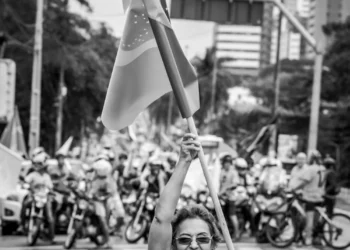by Alessandra Maia Terra de Faria, Carlos Trucíos, and Marcelos Cantañeda de Araújo
Reviewed by Matheus Lucas Hebling
Introduction
This research aims to follow the tweets related to the three main presidential candidates according to the opinion polls available for the 2022 elections in Brazil.
Methodology
Daily tweets spanning from June 1st to June 30th were collected for each one of the three main candidates in the Brazilian presidential election. Tweets were collected from both candidates’ timelines and Twitter users mentioning the candidates, totaling more than 13 million tweets. Data were extracted through a Twitter API used exclusively for academic purposes and analyzed using R software.
The authors thank Twitter for the academic accounts granted to them.
Results
General context
Followers
Herein is the updated data (June versus May, data as of July 19th, 2022) of Twitter followers for each of the candidates.
-
Bolsonaro – from 8.2 up to 8.4 million (2.4% increase in followers compared to the previous month) de 8,2 milhões para 8,4 milhões
-
Lula – from 3.6 up to 3.8 million (5.6% increase in followers compared to the previous month)
-
Ciro – from 1.3 up to 1.4 million (7.7% increase in followers compared to the previous month)
Candidates’ tweets
In Image 1, we report the number of tweets on the candidates’ timeline, among the three that were part of our survey: Lula, Ciro, and Bolsonaro, according to the frequency with which the candidates tweeted in June.
Image 1: Timelines
Images 2 and 3 present the most frequent words in the candidates’ timeline tweets and the most frequent words in the candidates’ timeline tweets weighted by the inverse document frequency (TF-IDF), respectively.

Image 2: Most frequently used words in the candidates’ timeline.
The analysis of the most frequent words in the candidates’ timeline tweets in Image 2 reveals a dominant overview of the subjects they deal with. In continuity with what was found in May, the term “Brazil” continues as something in common in the three profiles. In the profiles of Lula and Ciro, the terms “people” [“povo”] and “country” [“country”] are common. As an intersection between Lula and Bolsonaro, the common term found was “government” [“governo”]. In Lula’s profile alone, the verbs “to have” [“ter”] and “to do” [“fazer”] are highlighted, denoting a continuity of the propositional character already found previously, as well as the mention of words such as “folk” [“gente”], “today” [“hoje”] and “day” [“dia”]. In Ciro’s profile, the concern to name the other two candidates remains, as observed in April and May. It is possible to highlight, in data consolidated for the month of June, the mentions of “politics” [“política”], “about” [“sobre”], “large” [“grande”] and “all” [“todo”]. Finally, in Bolsonaro’s profile, it is possible to point out a continuity, concerning the months of April and May, with an emphasis in June on the government’s achievements, particularly, spending in “Reais (r)” expressed amount in “millions”. The consolidated novelty about the month of May appears in the mention of the term “jobs” [“empregos”] associated with these amounts, as well as “federal”, “years” [“anos”], and “2022”.
Image 3 TF-IDF by candidates’ timeline
In Image 3, the TF-IDF (term frequency-inverse document frequency) reflects the frequency of words in candidate timeline tweets that are infrequent for the three candidates overall. Thereby:
-
In Lula’s profile, there is a novelty within propositional actions consolidated in June, with emphasis given to the use of the verbs “to build” [“construir”] and “voltar” [“to come back”]. Fewer verbs are observed then the last month and, on the other hand, an increase in nouns such as “speech” [“fala”], “people” [“povo”], “poor” [“pobre”], “book” [“livro”], “because” [“porque”], “hunger” [“fome”], “folk” [“gente”], “together” [“juntos”] and “budget” [“orçamento”]. It is interesting to note that the highlight of June was the word “hunger”.
-
Bolsonaro’s profile highlights the English words “the”, “you” and “and”, which are due to the president’s participation in the Ninth Summit of the Americas (Los Angeles) but do not bring any important meaning to our analysis. The reference to the year “2019” has been maintained since April, showing an attempt to emphasize the government’s achievements in the year before the pandemic. The June news appears in the mentions of the words “waste” [“resíduos”], “Jair”, “products” [“produtos”], “pr” [for “president”], “round” [“rodada”], “logistics”[“logística”], “June” [“junho”] and “goods” [“bens”].
-
In Ciro’s profile, the novelty in June appears in the emphasis given to the terms “Ciro”, polarization” [“polarização”] and “Lula”. The words “team” [“turma”], “alive” [“vivo”], “folk” [“gente”] and “podcast”, as well as the terms “roll*” [list], “PDT” and “Brizola” are also mentioned.
*Rol in Portuguese means a list, in June happened a Public Audience at Brazilian Congress to discuss a “List of Procedures and Events in Supplementary Health” [“Rol de Procedimentos e Eventos em Saúde Suplementar”]. The document, edited by the National Supplementary Health Agency, lists the minimum mandatory coverage that health care plan operators are obliged to guarantee to their consumers in the private health care plans contracted.
Tweets about the candidate
The total number of tweets mentioning each candidate is displayed in Image 4 and the daily evolution in Image 5.

Image 4: Number of tweets mentioning the candidates.
In May, interactions around Bolsonaro’s name in June intensified, while interactions mentioning Lula and Ciro decreased. It is possible to highlight that the distance that once separated Bolsonaro from Lula increased. In April, that distance was almost 2 million tweets. In June, this difference surpasses two million. The number of tweets mentioning Lula represents approximately 63% of the total number of tweets mentioning Bolsonaro, returning to a level like that found in April (68.12%), but substantially different from the month of May (86.7%). The number of tweets mentioning Ciro is the lowest in the last three months. Compared to the previous month, the number of tweets mentioning Ciro dropped by more than 40%.
In the daily evolution of tweets (Image 5) Ciro has the lowest number of daily iterations. Although Bolsonaro presents a greater daily interaction in the number of tweets during the month, in four moments the tweets mentioning Lula were higher than those of Bolsonaro.
Image 5: Daily evolution of tweets mentioning the candidates.
Word clouds
Finally, we present below three-word clouds with, excluding stop words, the top 100 words used in the interactions of Twitter users in June. For better visualization, each candidate’s name was taken from its cloud.

Image 6: Word cloud for Bolsonaro
Image 7: Word cloud for Lula
Image 8: Wordcloud for Ciro
When analyzing the clouds, we share the first impression of each one:
-
Bolsonaro: in the foreground, the words “Lula”, “Brazil” and “government” [“governo”] are consolidated. In the background, “now” [“agora”], “against” [“contra”], “about” [“sobre”].
-
Lula: in the foreground appear “Brazil”, “PT” [“PT” for “Partido dos Trabalhadores”] and “president” [“presidente”]; in the background “against” [“contra”], “government”, “about” [“sobre”].
-
Ciro: the trend remained in the foreground, in an isolated way, the references to “Lula” and “Bolsonaro” stand out; in the background, “turn” [“turno”], “to vote” [“votar”] and “vote” [“voto”].
Sentiment analysis
The sentiment of each tweet was constructed by identifying the sentiments of the basic units (the words) using the Oplexicon v3.0 and Sentilex dictionaries, from the LexiconPT Package. Thus, each word found in the dictionaries receives 1, -1, or 0 scores, depending on whether the feeling is positive, negative, or neutral, respectively. Words not found in the dictionaries also receive a 0 score. The values assigned to each word within the tweet were added up, and depending on the result positive, negative, or zero, the sentiment of the tweet is classified. In Image 9, feelings (Negative, Neutral, and Positive) are presented in percentages per candidate. It is possible to highlight a balance between the feelings expressed in the tweets of the three candidates. Such data will be monitored over time comparatively. This is a portrait, a sentimental snapshot of June on Twitter.
Image 9: Sentiments of tweets per candidate
Next, it will be possible to look at the word cloud of each candidate, separately, according to the feelings attributed to each tweet, in Images 10, 11, and 12. Words in pink appear in tweets rated as associated with positive feelings, words in blue appear in tweets rated as associated with negative feelings, and words in beige appear in tweets rated as neutral.
The word clouds are considered the 200 most frequent words.

Image 10: Word cloud Sentiments for Bolsonaro

Image 11: Word cloud Sentiments for Lula

Image 12: Word cloud Sentiments for Ciro
-
Bolsonaro: Tweets related to candidate Bolsonaro that were classified as associated with positive feelings are characterized by words such as “world” [“mundo”], “to see” [“ver”], and “better” [“melhor”]. Tweets classified as associated with negative feelings are characterized by words such as “Bruno”, “guilt” [“culpado”], “guy” [“cara”], “hunger” [“fome”], and “Dom” (The names Bruno and Dom refer to British journalist Dom Phillips and Brazilian indigenous advocate Bruno Pereira, murdered in the Javari Valley, in the Amazon, last June). Finally, tweets considered neutral highlight the word “president” [“presidente”].
-
Lula: Tweets related to candidate Lula that were classified as associated with positive feelings are characterized by words such as “to see” [“ver”], “to know” [“saber”], “world” [“mundo”] and “good” [“bom”]. Tweets classified as negative are characterized by words such as “to vote” [“votar”], “hunger” [“fome”], “corruption” [“corrupção”] and “inmate” [“presidiário”]. Finally, tweets with a neutral sentiment are mainly characterized by the name “Bolsonaro”.
-
Ciro: Tweets related to candidate Ciro that were classified as associated with positive feelings are characterized by words such as “best” [“melhor”], “knows” [“sabe”], and “needs” [“precisa”]. Tweets classified as negative are characterized by words such as “to vote” [“votar”], “guy” [“cara”] and “blame” [“culpa”]. Finally, tweets with neutral sentiment are characterized by words like “Lula”, “Bolsonaro” and “president” [“presidente”].
Bigrams
The 25 most frequent bigrams in tweets mentioning each of the candidates are shown in Images 13 to 15. The direction of the zeta reveals the order in which the bigram appears and the greater the intensity of the zeta, the greater the frequency of the bigram.

Image 13: Bigrams of Bolsonaro
Bolsonaro: among the most frequent bigrams we have “government => Bolsonaro”, “Jair => Bolsonaro” and “president => Bolsonaro”. Following these we have the sequence “President => Jair”, “Milton => Ribeiro”, “fake => news”. It is also important to mention the bigram “Dom => Philips” evidencing the repercussion of the murder of the English journalist in Amazonia.

Image 14: Bigrams of Lula
Lula: among the most frequent bigrams we have “first => turn” [“primeiro=>turno”], “ex => inmate” [“ex => presidiário”], “Abílio=>Diniz” and “government => Lula”. Other bigrams, but with less prominence, are “Lula => president”, “Gilmar => Mendes” [Supreme Court Minister], “Renan => Calheiros” [ State Senator of Alagoas], “digital => brigades” [“brigadas => digitais”], “going => vote [“vou => votar] and “Car => Wash” [“Lava => Jato” for “Operação Lava Jato”].

Image 15: Bigrams of Ciro
Ciro: among the most frequent bigrams we have, predominantly, “Ciro => Gomes”, “I will => vote” [“vou => votar”], “pre=>candidate” [“pré => candidato”], “ex=>president”, among many others.
Final comments
The presentation of this dataset aims to contribute to interpretations of the movement on Twitter of possible candidates in the 2022 elections, as well as about what is said about them in the interactions of users of the platform throughout the month of June, in comparison to April, that can be found here and in comparison to May, that can be found here. This is ongoing research work and will be refined over the months leading up to the 2022 election.
Alessandra Maia Terra de Faria, Social Sciences Department at PUC-RIO / PPGCS – UFRRJ. E-mail: alessandramtf@puc-rio.br
Carlos Trucíos, Department of Statistics, University of Campinas. E-mail: ctrucios@unicamp.br
Marcelo Castañeda de Araujo, Department of Business/UFRJ.
Araujo, Alessandra Maia Terra de Faria, Carlos Trucíos and Marcelo Castañeda de. 2022. "June: Brazilian presidential candidates on Twitter". Brazilian Research and Studies Blog. ISSN 2701-4924. Vol. 3 Num. 1. Available at: https://www.bras-center.com/june-brazilian-presidential-candidates-on-twitter/, accessed on: April 15, 2025.














